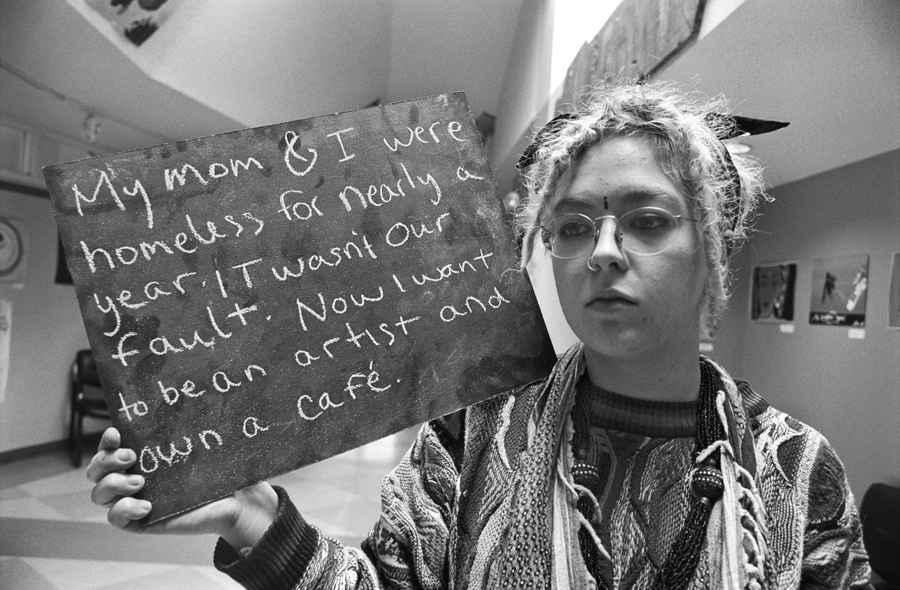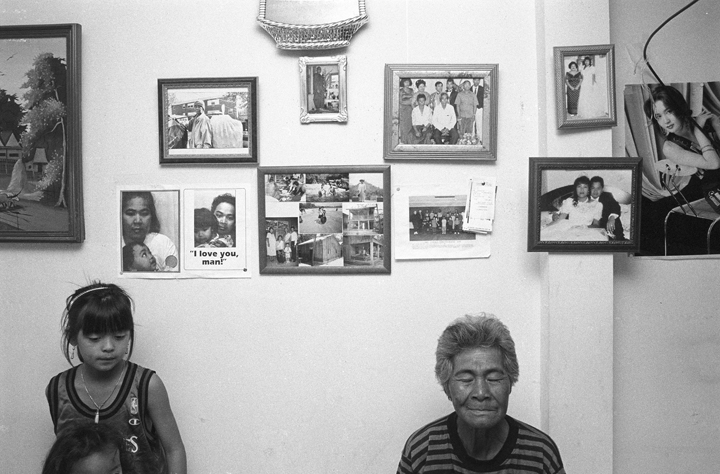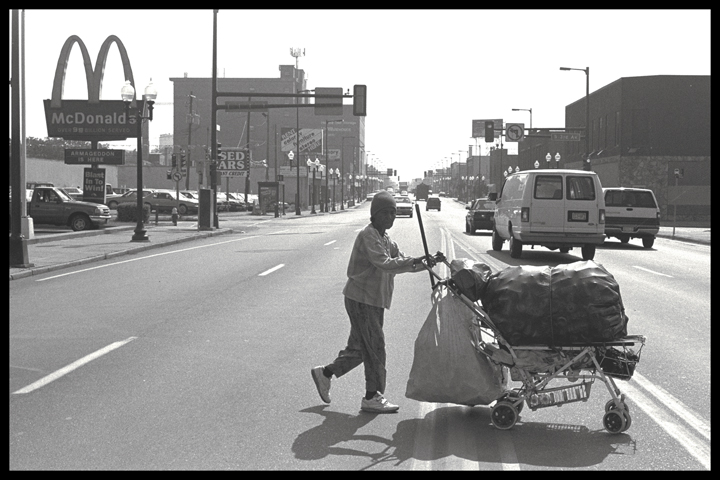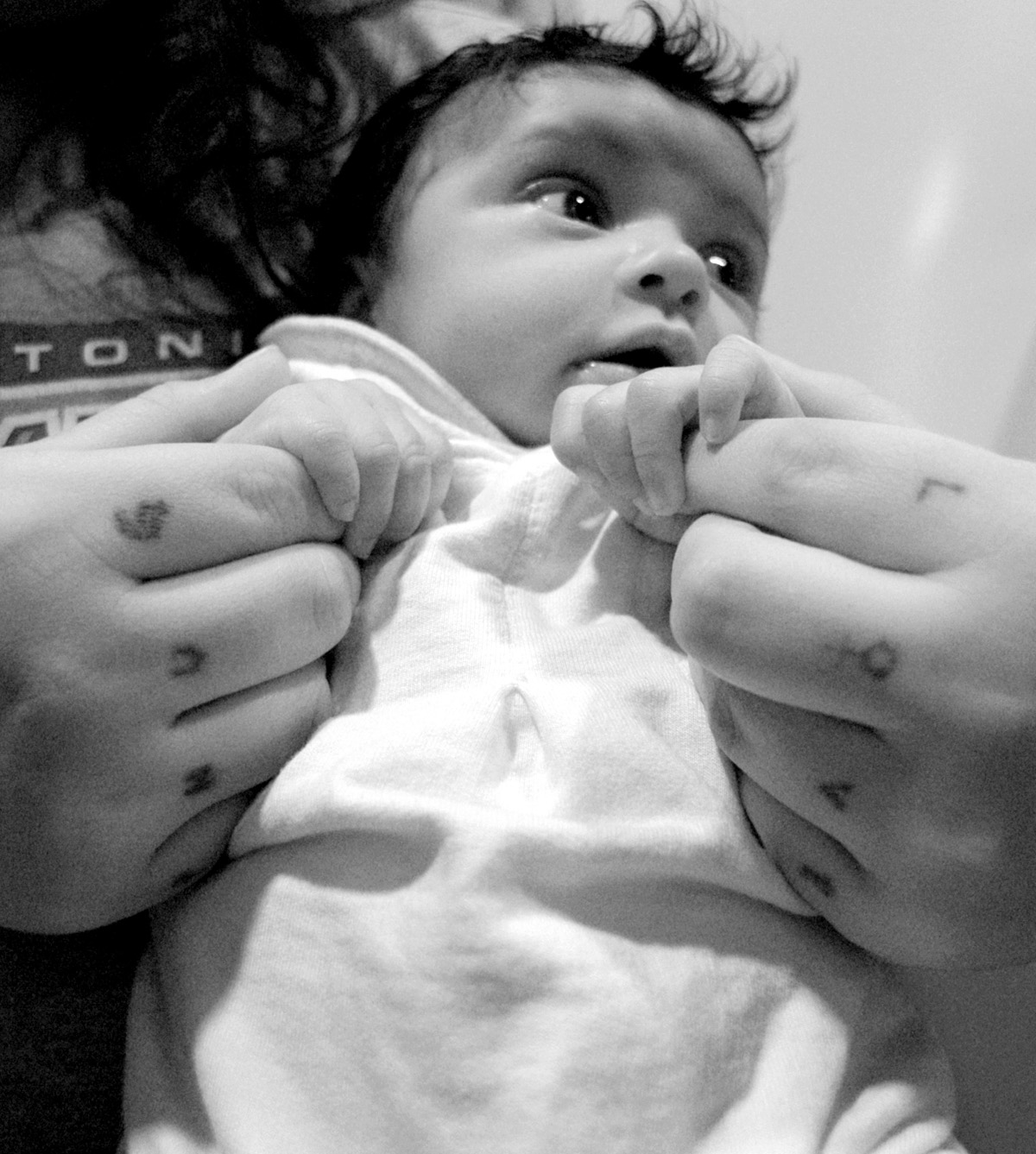A Voice for Homeless Youth
Marsha Trainer reports on a new project, "Growing Home: Ending Youth Homelessness," featuring photography by Wing Young Huie and Cathy ten Broeke, alongside artwork and performance created by kids with first-hand experiences of homelessness.






THE CONCEPTS OF CHARITY, AID, AND ASSISTANCE often bring to mind a tableau of long lines, desperate individuals, and dingy, dilapidated surroundings. One step into the new Center for Changing Lives (CFCL) in the Phillips neighborhood dispels those images immediately: a modern, beautiful building, it houses a myriad of social service providers under one roof, including those specializing in adoption, pregnancy, financial, refugee, family, housing, and employment counseling, as well as a food pantry, affordable housing units, and more.
How apropos, then, that the art project, Growing Home: Ending Youth Homelessness, will host its opening reception on-site in this center, a space where social advocacy actually takes place? In fact, the exhibition is CFCL’s fourth issue-based art project to date, and promises to combine high-level professional art, discourse about youth homelessness, photography and spoken word by young people who know firsthand what it means to be homeless, and art by the children enrolled and mentored at the center.
The first stage of the project happens Thursday evening, January 27, and will feature the art of Wing Young Huie, Cathy ten Broeke, and youth from the Kulture Klub Collaborative, in addition to a panel discussion about the issue of youth homelessness, and remarks from State Senator Scott Dibble. The project will also include a children’s response show, displayed a few months from now, reflecting the problem through the eyes of the kids of Kaleidoscope Place, an afterschool and summer program that is housed at the Center for Changing Lives. The entire Growing Home project was conceived and organized by community-based arts consultant, Reggie Prim.
Prim served as one of the principal architects of the Walker Art Center’s Art and Civic Engagement: Mapping the Connections project, and he’s clearly following those fundamentals now at the Center for Changing Lives. He says he sees Growing Home as a chance to “place art in a social context. I’m committed to activating the power of the art to engage people in thinking about an issue.”
To that end, renowned photographer Wing Young Huie’s involvement was both relevant and serendipitous. Prim says, “Wing was the inspiration for the show. I ran into him at the gym and told him, ‘I’m struggling,’ and [the project] grew from there.” A selection of both black-and-white and color photographs from Huie’s Lake Street and University Avenue projects will anchor the show.
As Huie finds his subjects, literally, on the street, his photographs fit perfectly into the Growing Home story. The images he creates speak to identity, diversity, and seeing what is right in front of us, yet somehow too easily missed; he frequently shares his talents with underserved populations, such as shelter residents and at-risk kids, but he makes clear that he is not an expert on the issue of youth homelessness or any other social ill. Huie’s role in the exhibition is simply that of artist. About his part in the process, he says, “I try not to think too much about the specific outcomes. Rather, I look at my work as a culture mirror, almost as though I’m collecting bits of reality and putting them out there, where it’s up to the viewers to decide the values or impacts of what [they see], by looking at it.”
Huie doesn’t remember what he might have said that inspired Prim that day at the gym, but he does remember one contribution he made. “I suggested Cathy ten Broeke, who I met playing basketball. She’s a real player.” Ball playing ability notwithstanding, Huie’s suggestion was brilliant. Cathy ten Broeke is not only the coordinator of the Office to End Homelessness for the City of Minneapolis and Hennepin county, but also a documentary-style photographer in her own right. And her commitment to the issue homelessness has been tireless. “Homelessness has been the focus of my work all of my adult life — breaking the cycle for men, women, children, and youth. Then, I started to fool around with photography,” she says. “All the photos I had seen of homeless people seemed to depict them in unflattering ways,” she says. Ten Broeke felt that, with her knowledge and experience, she could somehow help tell their stories of transition in a more empowering way. With support from her good friend, Huie, she’s since developed her own photographic craft and process.
“For all of these images that you’ll see, and most anything I’ve done on homelessness, I’ve spent half a day with each of my subjects, learning their story. I become close to them,” she explains. Among her contributions for the exhibition at the center of Growing Home, she contributed two such black-and-white photographs, one of a teenage mother holding her baby and the other a shot of a young pregnant woman at a Duluth drop-in center. Huie, ten Broeke, and several others will speak on a panel at the January 27 event, which will be moderated by Prim.
______________________________________________________
“We can talk about departments and statistics,
but art opens doors that otherwise don’t get opened.”
______________________________________________________
While ten Broeke is pleased to present both sides of her work to the crowd — as an advocate and as an artist — she’s most honored to have her work featured alongside the kids’. A spoken word performance, as well as photographs and house structures made by young people in the Kulture Klub Collaborative will be also part of the opening festivities and ongoing show. Local artists Peter Haakon Thompson and Lauri Lyons guided the youth-created art projects on exhibit in Growing Home. The 18-year-old Kulture Klub Collaborative provides art services to homeless youth at the YouthLink drop-in center in downtown Minneapolis. For director Jeff Hnilicka, participation in Growing Home was an obvious fit, given the organization’s direct relationship to the stated focus of the evening. Hnilicka sees this event as a way to bring the plight of homeless youth to a larger public audience. “This population is hidden and out of view. Homelessness has a problem of invisibility — this sheds a little more light,” he says.
Susan Phillips, director of the Lutheran Social Services (LSS) Homeless Youth Services in St. Paul, agrees, “I hope [with our participation] we broaden the general public’s awareness of what we need to do together to help this population. And I hope to add artists to the fold,” she says. Phillips will be another of the panelists involved in the discussion for Growing Home‘s opening reception.
In the coming months, as mentioned above, the children of Kaleidoscope Place will formulate a response to this first set of exhibited photos and mixed media. For Kaleidoscope Place’s executive director, Quendy Raymond, Growing Home completes an amazing circle in her own life. A Kulture Klub alumnus herself, she says that her introduction to the arts through that program helped her “put a voice to the experience I was going through.”
As Prim removed the old photographs from the lobby of the center to prepare for the opening of Growing Home, Raymond says she realized the power of their presence. “It’s such a joy when he puts up a new show. It really struck me when the walls were blank — how sterile it was.” She observes that the art created and displayed through these initiatives has given the building a warmer feel — for her, the kids, and all the people who seek counsel there.
The third through eighth graders at Kaleidoscope Place have been working for eight weeks with artist Chloe DeJong Hilden, who specializes in multimedia art. They’ve been journaling about the theme of youth homelessness, and about what defines and creates a home. Next, the Kaleidoscope students will work with a fiber artist, looking at how different cultures and groups tell their stories through their use of fabric. From these lessons, the kids’ art will emerge and ultimately, will be curated by Prim for the response show later this spring.
LSS’s director of Volunteer and Advocacy Services, Kirsten Anderson-Stembridge, loves the inclusion of the center’s younger set. “I think it’s just awesome. We all get to see through the eyes of children and understand their wisdom and experience,” she says. Everyone seems to agree: using art in this way — to spur expression, education, and to provide context for topical events illuminating the issues being addressed by the Center for Changing Lives — is a fresh and exciting endeavor. “Everyone can be part of the experience of art — simply by partaking in the art itself, they can be touched. That opens up a proactive and positive lane [for discussion of the issues],” says Anderson-Stembridge.
Ten Broeke, in her dual role as artist and expert on the problem, sees a real opportunity to bring new people and perspectives to the conversation surrounding youth homelessness. “I can talk about departments and statistics, but art opens doors that otherwise don’t get opened.”
______________________________________________________
Related events and exhibition details:
Growing Home: Ending Youth Homelessness will host an opening reception for the exhibition, featuring performances by the youth of Kulture Klub Collaborative and a panel discussion on the issue of youth homelessness, on Thursday, January 27 at 5:30 pm at the Center for Changing Lives in Minneapolis (admission is free and open to the public; food and drink will be provided).
Artwork created for the project, photographs by Wing Young Huie and Cathy ten Broeke, will be exhibited in the center’s lobby through May 14. Artwork by the children, created in response to the work on view, will be displayed in the months to come.
______________________________________________________
About the author: Marsha Trainer created and curates a blog, Skyway of Love, that highlights public art in and around downtown Minneapolis. When not obsessing about the skyway system or food blogging for City Pages, she produces narrative and documentary films, including the award-winning short, Ana’s Playground.